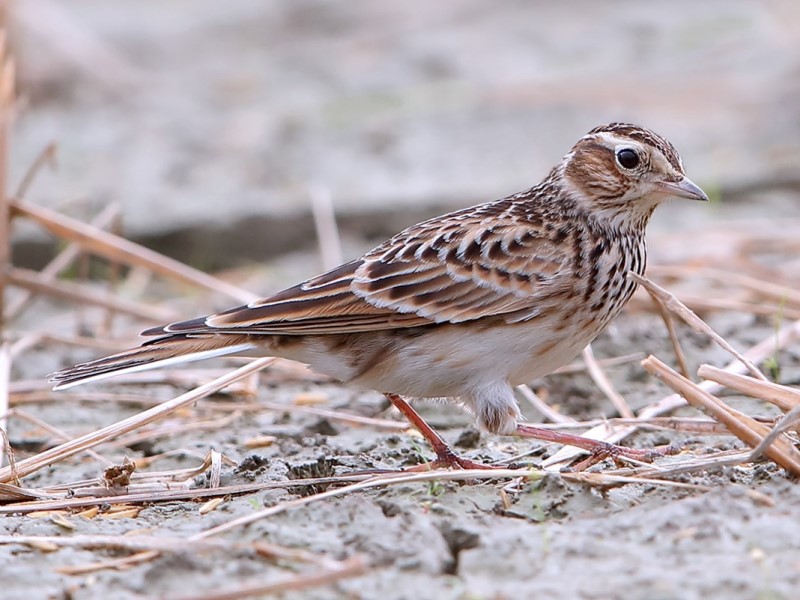Eurasian Skylark Alauda arvensis 雲雀
Category I. Locally common passage migrant in autumn and scarce in winter and spring, mainly in open-country lowland areas.
IDENTIFICATION

Nov. 2018, Michelle and Peter Wong.
17-19 cm. Very similar to the rare Oriental Skylark compared to which it is slightly larger and has a relatively shorter and thicker less pointed bill, longer tail with white outer tail feathers, a distinct white trailing edge to inner wing, longer primary projection beyond tertials and longer crest (Alström 2020).
VOCALISATIONS
The typical flight call heard in HK is a liquid, downslurred ‘chirrrup,’ similar to the final call of this recording, but the other types can also be heard.
DISTRIBUTION & HABITAT PREFERENCE
Occurs in open country and grassy areas such as the Deep Bay area and Long Valley.
OCCURRENCE
Figure 1 illustrates the pattern of occurrence since the first record in 1982 and indicates that Eurasian Skylark is mainly a migrant in late autumn, with numbers highest from the second week of October to the second week of November. Numbers then decline and remain low through the winter until a small increase in the third week of March indicating weak spring passage. Extreme dates are 1 October 2013 and 13 April 2016. The largest numbers occurred in late October 2010 when ponds 16/17 at Mai Po NR were dry and grassy, and the highest count was 15 on the 28th.
Although the number of records submitted has gradually increased over the years, especially since 2010, it is considered this is due to increased observer familiarity with the species call and habits and more intensive coverage of Long Valley and Mai Po NR. Thus, at the latter site more frequent trapping in a location better-suited for monitoring early morning diurnal migration has resulted in a relatively large number of records, while increased coverage at Long Valley has allowed more birds to be found on the ground.
Kershaw (1904) regarded this species as common in winter at the mouth of the Pearl River delta, but this may refer to Oriental Skylark. Vaughan and Jones (1913) noted that it was met with ‘occasionally’ in winter.
BEHAVIOUR, FORAGING & DIET
May be seen in autumn in early morning migratory flight. Although most such records are of birds flying west over fishpond areas and, in particular, Mai Po NR, such records also come from elsewhere (e.g., Tung Lung Chau).
No detailed information on diet, but birds have been observed consuming seeds.
RANGE & SYSTEMATICS
Breeds from Europe and coastal north Africa east across Eurasia to Kamchatka and Sakhalin between 35oN and 70oN; northern populations in Asia and eastern Europe are migratory, wintering as far as Oman and south China (Campbell et al. 2020). In China, a summer visitor to grassland in arid areas of the northwest and north, as well as lowland areas of the northeast, and a winter visitor south of the Chang Jiang (Yangtze River) according to Liu and Chen (2021).
Of the approximately 12 subspecies recognised, those with the greatest potential to occur in HK are A. a. kiborti (breeding in south Siberia, north and east Mongolia, northeast China), A. a. intermedia (north central Siberia to northeast China and Korean Peninsula), A. a. pekinensis (northeast Siberia, Kamchatka and the Kuril Is.) and A. a. japonica (south Sakhalin, south Kuril Is., Japan and Ryukyus).
CONSERVATION STATUS
IUCN: Least Concern. Population trend decreasing.
Figure 1.

Alström, P. (2020). Oriental Skylark (Alauda gulgula), version 1.0. In Birds of the World (J. del Hoyo, A. Elliott, J. Sargatal, D. A. Christie, and E. de Juana, Editors). Cornell Lab of Ornithology, Ithaca, NY, USA. https://doi.org/10.2173/bow.orisky1.01
Campbell, R. W., L. M. Van Damme, S. R. Johnson, P. Donald, and E. F. J. Garcia (2020). Eurasian Skylark (Alauda arvensis), version 1.0. In Birds of the World (S. M. Billerman, Editor). Cornell Lab of Ornithology, Ithaca, NY, USA. https://doi.org/10.2173/bow.skylar.01
Kershaw. J.C. (1904). List of birds of the Quangtung Coast, China. Ibis 1904: 235-248.
Liu, Y. and S. H. Chen (eds) (2021). The CNG Field Guide to the Birds of China (in Chinese). Hunan Science and Technology Publication House, Changsha.
Vaughan, R. E. and K. H. Jones (1913). The birds of Hong Kong, Macao and the West River or Si Kiang in South-East China, with special reference to their nidification and seasonal movements. Ibis 1913: 17-76, 163-201, 351-384.

